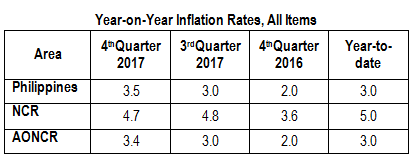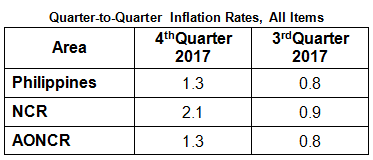FOURTH QUARTER 2017
YEAR-ON-YEAR
Philippines

The country’s year-on-year inflation for the bottom 30% income households went up by 3.5 percent in the fourth quarter of 2017. In the previous quarter, the annual gain was observed at 3.0 percent and in the same period in 2016, 2.0 percent. All the commodity groups posted higher annual growths during the quarter:
- Food, beverages and tobacco (FBT) (3.5%);
- Clothing (1.4%);
- Housing and repairs (H&R) (2.9%);
- Fuel, light and water (FLW) (6.2%);
- Services (1.8%); and
- Miscellaneous (1.0%) (see Table 9).
The annual average inflation for the bottom 30% income households for the year 2017 was registered at 3.0 percent. This was higher compared to 1.4 percent in 2016. Higher annual average rates for the year 2017 were seen in all the commodity groups except clothing index which exhibited a slower annual average growth of 1.0 percent during the year from 1.2 percent in 2016 (see Table 7).
The annual increment of the food alone index at the national level picked up by 3.4 percent in the fourth quarter of 2017. Its annual rate was recorded at 3.0 percent in the previous quarter and 2.2 percent during the same period in 2016 (see Table 17).
Faster annual mark ups were observed in the indices of the following food groups:
- Corn (5.5%);
- Cereal preparations (1.8%);
- Dairy Products (1.2%);
- Fish (9.4%); and
- Meat (5.8%).
The other food groups posted slower annual increases during the quarter, with the miscellaneous foods index still on a downtrend at -0.1 percent (see Table 15).
The annual average inflation for the year 2017 of the food alone index at the national level rose by 3.0 percent. In 2016, the annual average growth was seen at 1.7 percent. Higher annual average rates for 2017 were noticed in all the food groups except for the indices of dairy products, fruits and vegetables, and miscellaneous foods. The annual average growth for the index of rice climbed by 1.2 percent in 2017 from -0.1 percent in 2016 (see Table 19).
| Year-on-Year Inflation Rates in the Philippines, All Items 1st Quarter 2009 - 4th Quarter 2017 | |||||||||
|---|---|---|---|---|---|---|---|---|---|
| Quarter | Year | ||||||||
| 2009 | 2010 | 2011 | 2012 | 2013 | 2014 | 2015 | 2016 | 2017 | |
| 1st | 12.3 | 4.2 | 4.6 | 2.7 | 3.5 | 5.7 | 3.1 | 1.1 | 2.8 |
| 2nd | 5.5 | 3.5 | 5.4 | 2.4 | 3.1 | 6.5 | 2.1 | 1.2 | 2.7 |
| 3rd | 0.2 | 3.7 | 5.2 | 3.1 | 3.5 | 6.8 | 0.4 | 1.4 | 3.0 |
| 4th | 3.4 | 3.1 | 5.2 | 3.0 | 4.8 | 5.1 | 0.8 | 2.0 | 3.5 |
| Average | 5.4 | 3.6 | 5.1 | 2.9 | 3.7 | 6.0 | 1.6 | 1.4 | 3.0 |
National Capital Region (NCR)
The annual growth of prices for this particular group of consumers in NCR decelerated to 4.7 percent in the fourth quarter of 2017. In the previous quarter, inflation was recorded at 4.8 percent, while in the fourth quarter of 2016, it was observed at 3.6 percent. Slower annual increments were noted in the indices of FBT at 4.1 percent; clothing, 1.7 percent; and miscellaneous, 3.9 percent. Meanwhile, the index of FLW had a double-digit annual change of 11.3 percent during the quarter. Moreover, higher annual gains were posted in the indices of H&R at 2.1 percent and services, 2.6 percent (see Tables 8 and 12).
A lower annual gain of 3.9 percent was registered in the food alone index in the area during the fourth quarter. The annual rate was pegged at 4.9 percent in the previous quarter and 5.1 percent in the same quarter of 2016 (see Table 17).
The annual movement in the index of rice further decreased by 2.2 percent. Similarly, the index of eggs posted an annual decline of 3.7 percent. In addition, the annual growth of fruits and vegetables index slowed down to 2.1 percent this quarter after posting a double-digit annual mark-up of 12.1 percent in the third quarter. The annual upticks in the indices of corn and cereal preparations likewise decelerated to 2.0 percent and 3.1 percent, respectively.
On the other hand, higher annual hikes were recorded in the indices of the rest of the food groups (see Table 15).
Areas Outside NCR (AONCR)
Annual inflation in AONCR for the bottom 30% income households picked up by 3.4 percent during the fourth quarter of 2017. In the previous quarter, the annual growth was seen at 3.0 percent and in the same quarter of 2016, 2.0 percent. All the commodity groups exhibited higher annual rates during the quarter:
- FBT (3.5%);
- Clothing (1.3%);
- H&R (2.9%);
- FLW (6.1%);
- Services (1.8%); and
- Miscellaneous (1.2%).
Ten (10) regions posted faster annual increments during the period, with ARMM registering the highest annual rate of 6.2 percent. Meanwhile, the lowest annual growth of 0.9 percent was seen in MIMAROPA (see Tables 9 and 12).
The annual adjustment of the food alone index rose by 3.4 percent in the fourth quarter of 2017. Its annual rate was pegged at 2.9 percent in the previous quarter and 2.2 percent in the same quarter in 2016 (see Table 17).
The following food groups registered higher annual growths during the quarter:
- Corn (5.5%);
- Cereal preparations (1.8%);
- Dairy products (1.1%);
- Fish (9.4%); and
- Meat (5.8%).
The annual increase of the index of rice slowed down to 1.4 percent. Moreover, the miscellaneous foods index still had a negative annual rate at -0.2 percent (see Table 15).
QUARTER-ON-QUARTER

On a quarterly basis, prices of consumer items for the bottom 30% income households at the national level went up by 1.3 percent during the fourth quarter of 2017. Its rate was observed at 0.8 percent in the previous quarter. Higher quarterly growths were noted in the indices of FBT at 1.3 percent; FLW, 2.9 percent; and miscellaneous, 0.4 percent. The rest of the commodity groups registered slower quarterly increases (see Tables 4 and 11).
In NCR, quarter-on-quarter adjustment of consumer prices for this income group accelerated by 2.1 percent during the fourth quarter of 2017. The uptrend was brought by the 6.5 percent growth in the FLW index from a decline of 1.8 percent in the previous quarter. The heavily-weighted FBT index likewise climbed by 1.8 percent. The other commodity groups had slower rates (see Tables 5 and 11).
Consumer prices in AONCR for this income category generally went up by 1.3 percent in the fourth quarter of 2017. In the previous quarter, it was posted at 0.8 percent. Increases were higher in the indices of FBT at 1.3 percent; FLW, 2.7 percent; and miscellaneous, 0.4 percent. On the other hand, the growths in the indices of clothing, H&R, and services decelerated during the quarter (see Tables 6 and 11).
Faster quarterly average increments were seen in 11 regions, with the highest rate of 2.1 percent recorded in CALABARZON. In addition, the quarterly change in Caraga picked up by 0.7 percent from zero growth. Meanwhile, the lowest average quarterly rate was noted in Western Visayas at 0.6 percent (see Table 11).
Prices of selected food items such as fish, fruits and vegetables, and seasonings were higher in many regions. The difficulty in catching fish due to bad weather conditions brought about by typhoons “Urduja” and “Vinta” in December lowered its supplies in the markets. This factor raised prices of fish during the period. Higher charges in electricity rates, together with price hikes in kerosene, LPG, and cigarettes in many provinces also contributed to the uptrend.
Note:
Monthly CPIs for the bottom 30% income households by province and selected cities are also available upon request at PSA, Price Statistics Division (Telephone Number: 376-1959)
